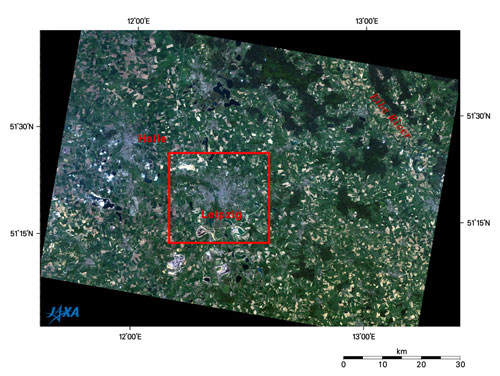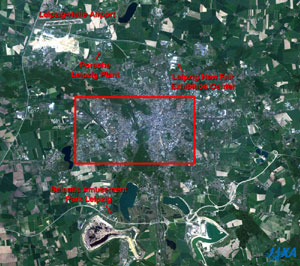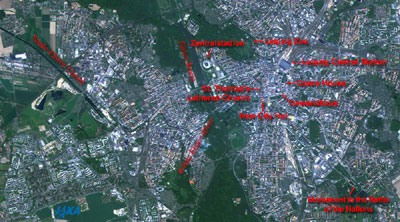| |
In this issue, we introduce Leipzig using the latest image observed by ALOS (Daichi). It was selected as a venue of the World Cup football championships as the only city from former East Germany.
 |
| Fig. 1. Leipzig and Vicinity |
Figure 1 depicts Leipzig and its vicinity observed in May 2006 by the Advanced Visible and Near-Infrared Radiometer 2 (AVNIR-2) aboard the Advanced Land-Observing Satellite (ALOS) "Daichi." The population is approximately 500,000, exceeding that of Dresden, the state capital, which is approximately 490,000. The Elbe River flows through the northwest as seen in the upper right of the figure. At the center of the figure, Leipzig, located on the White Elster River, looks bluish gray. The White Elster River joins the Saale River in Halle and the Saale River joins the Elbe River. The city area in Halle can be seen on the left of the figure, and the Leipzig-Halle Airport is between the two cities. Most of the area is covered with farmland and pastures and appears green or ocher in color. The forests are dark green.
 |
| Fig. 2. Expanded Image of Leipzig |
Figure 2 is an expanded image of Leipzig. The Leipzig-Halle Airport can be seen in the upper left of the figure. The present runway is located on the north side of the expressway (autobahn). Just south of the autobahn is the previously demolished runway that is presently under re-construction. East of the airport, you can see the Leipzig Porsche Plant that began operation in August 2002. The Leipzig New Fair Exhibition Center is also on the east side. The Belantis Amusement Park Leipzig can be seen near the bottom of the figure. These facilities are situated along the autobahn that extends around the city area of Leipzig in the center of the figure. Lakes and some reservoirs can be seen at the top and bottom of the figure.
 |
Fig. 3. City Area of Leipzig
Leipzig(kmz, 2.11MB, Low Resolution) as seen on Google Earth. |
Figure 3 is an expanded image of the city area of Leipzig. At the center of the figure is the white ring-shaped Zentralstadion (central stadium) selected as a venue of the 2006 World Cup football championships. On the west side of the stadium you can find the White Elster River that flows northward through the Elster Basin. The Saale-Elster Canal can be seen on the left side of the figure.
On the east side of the Zentralstadion, is the large rectangle of the Leipzig Central Station that is one of the largest stations in Europe. Also, to the east is the Opera House, the second oldest in Germany with more than 300 years of history; the New City Hall with the red roofs; and the Leipzig Zoo, one of the oldest and most varied zoos in the world. In St. Thomas's Lutheran Church, Johann Sebastian Bach (1685-1750) served as Cantor, organist and conductor of the chorus from 1723 to 1750, and his remains are interred there. The Gewandhaus (originally meaning the textile warehouse) is the home of the Leipzig Gewandhaus Orchestra that is the world's oldest private orchestra with a history of over 250 years dating back to the time of J. S. Bach.
West of the Gewandhaus is the main building of Leipzig University founded in 1409 where Johann Wolfgang von Goethe (1749-1832), Friedrich Wilhelm Nietzsche (1844-1900) and Ogai Mori (1862-1922) were educated.
The Monument to the Battle of the Nations, the highest monument in Europe at 91 m, can be seen at the lower right of the figure. That is the place where on October 16-19, 1813 allied troops from Prussia, Russia, Austria and Sweden surrounded and defeated Napoleon Bonaparte (1769-1821) and his French troops in the Battle of Leipzig, ending Napoleon's rule over Germany. This monument was erected in 1913, 100 years after the battle to mourn all soldiers killed in the battle.
The multi-family, high-rise housing is represented by geometrical shapes in the upper right and lower left of the figure.
Explanation of the images:
Figs. 1 to 3
| Satellite: |
Advanced Land-Observing Satellite (ALOS) (Daichi) |
| Sensor: |
Advanced Visible Near-Infrared Radiometer type-2 (AVNIR-2) |
| Date: |
1256 (UT) on May 5, 2006 |
| Ground resolution |
10 m |
| Map Projection: |
Universal Transversal Mercator (UTM) |
|
AVNIR-2 is an upgraded version of the high-resolution AVNIR instrument on board the Advanced Earth-Observing Satellite (ADEOS). AVNIR-2 is equipped with a function by which it can shift its direction of observation to be perpendicular to ALOS's moving direction. The color composition was made by using three out of four AVNIR-2 bands: visible (610 to 690 nm, band 3) for red, visible (520 to 600 nm, band 2) for green, and visible (420 to 500 nm, band 1) for blue. As a result, the figures have a natural coloring. These images can be interpreted as follows.
|
| Dark green: |
Forests |
| Light green or light brown: |
Grasslands, or farmlands |
| Bluish gray: |
City area or roads |
| Red, blue, white: |
Roofs of buildings |
| Dark blue: |
Water surfaces (lakes, reservoirs or rivers) |
|
 |
Related Sites:
 Munich: The capital of the German Federal State of Bavaria Munich: The capital of the German Federal State of Bavaria
 Venues of Football World Cup Seen from Space Venues of Football World Cup Seen from Space
 Hamburg and the Kiel Canal connecting the North Sea and the Baltic Sea Hamburg and the Kiel Canal connecting the North Sea and the Baltic Sea
 Berlin: The city divided by a wall (Part2) Berlin: The city divided by a wall (Part2)
 Berlin: The city divided by a wall (Part1) Berlin: The city divided by a wall (Part1)
 Land, Seen from Space Land, Seen from Space
Appendices:
The musicians connected with Leipzig:
Georg Philipp Telemann (1681-1767), who composed in the Baroque style of music, learned jurisprudence in Leipzig University, and was said to be more popular than J. S. Bach and Handel who were contemporary composers.
The great baroque composer and organist Johann Sebastian Bach (1685-1750), a member of the Bach musical family, composed approximately 2,000 works, but did not write any operas.
The Romantic composer Felix Mendelssohn (1809-1847) revived J. S. Bach's forgotten St. Matthew's Passion, served as the first primary conductor in the Leipzig Gewandhaus Orchestra and founded the Leipzig Conservatory.
The Romantic composer Robert Schumann (1810-1856) studied law at Leipzig University and Heidelberg University, but he could not abandon his dream to become a musician. He studied under the famous piano teacher, Friedrich Wieck and became a music critic and a composer. He married Wieck's daughter, Clara.
Wilhelm Richard Wagner (1813-1883), the composer of opera and musicals, was born in Leipzig.
Clara Schumann (1819-1896) born in Leipzig, was a successful pianist from childhood. Her dynamic performances aided in supporting her children after her husband Robert died. Her likeness was selected as the design for 100 Deutsche Mark bank notes.
Rentaro Taki (1879-1903) began his study abroad in April 1901, at Leipzig Conservatory founded by Mendelssohn. Two months into his studies, he contracted tuberculosis and eventually, after a year of suffering with the ailment, retuned home. This was the the first time that a Japanese musician had traveled abroad to study in Europe.
The musicians connected with Halle:
George Frederick Handel (1685-1759), was born in Halle the same year as J. S. Bach. He was called the greatest composer of baroque music, and an equal to J. S. Bach. He studied law at Halle University, but could not curtail his enthusiasm for music. He went to Hamburg and became a composer. Later, he emigrated to London in 1712 and became a citizen of the United Kingdom in 1727.
|
|







